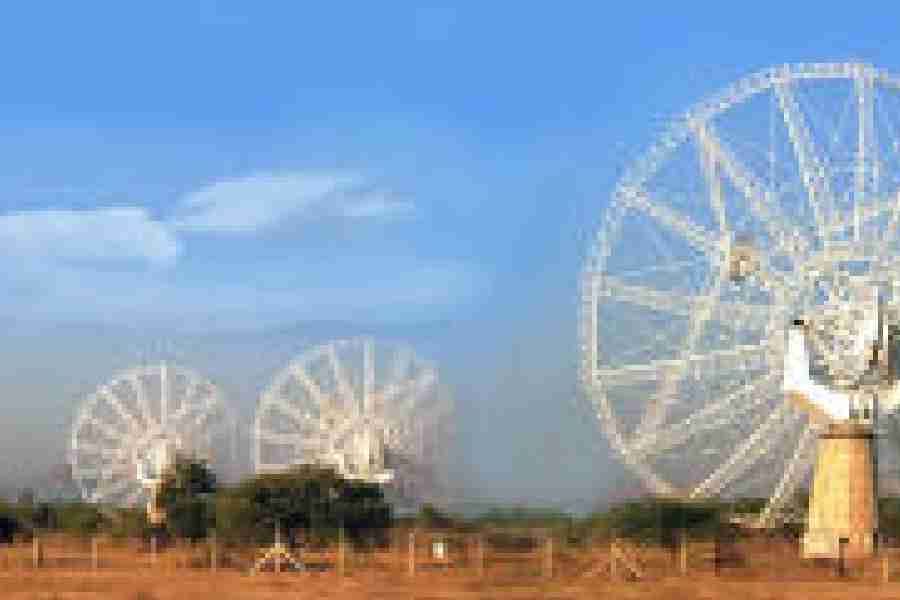Bhal Chandra Joshi was a PhD student in astronomy when he first heard what many had dismissed as a preposterous proposal — the use of radio telescopes on Earth to set up a galaxy-sized experiment and look for gravitational waves. It was 1995. An American astrophysicist Donald Backer, who had conceived the experiment, had discussed the idea with Joshi’s supervisor Govind Swaroop at the National Centre for Radio Astronomy (NCRA), Pune.
Swaroop, NCRA director, had designed and just helped build the Giant Metrewave Radio Telescope (GMRT), a set of 30 bowl-shaped45-metre dish antennas, nestled amid grape and sugarcane fields about 80 kilometres north of Pune. He shared Backer’s enthusiasm that the GMRT would someday play a role in the experiment. Backer died in 2010 and Swaroop passed away in 2020, but their shared visions were achieved last week by a new generation of scientists.
Joshi is among the principal investigators of a global science collaboration of multiple research groups that last week released data that provide the strongest evidence yet for the existence of an all-pervasive gravitational wave background — a continuous stream of ripples in space-time across the universe.
The teams from Australia, China, Europe, India, Japan and North America had measured delays in radio signals emitted by burnt-out dead stars called pulsars scattered across the galaxy. Pulsars spin rapidly, hundreds of times a second, emitting near-perfect timed radio signals with each rotation.
Backer, a faculty member at the University of California, Berkeley, US, had proposed in the late-1980s that signals from pulsars could be used to detect ripples in space-time caused by gravitational waves.
Albert Einstein had first proposed gravitational waves in 1916 but it wasn’t until 2015 that scientists detected them — high-frequency, short-lasting waves triggered by the collision of distant black holes, dead stars with so much mass that not even light can escape their gravity. Since 2015, astronomers have documented at least 90 more such waves that last no longer than some fractions of seconds.
The new evidence indicates low-frequency gravitational waves that scientists believe could last years to decades, quitedifferent from the short-lasting waves, and points to what some refer to as a cosmic gravitational wave background.
This signal is like a continuous background murmur in a noisy room as opposed to shouts picked up in the earlier gravitational wave detections, said Katerina Chatziioannou, an assistant professor at the California Institute of Technology and member of the North American Nanohertz Observatory for Gravitational Waves (NANOGrav), US.
“The upgraded GMRT today is in the best position among radio telescopes worldwide for specific measurements that are criticalto eliminating noise that can interfere with signals we’re looking for,” said Joshi, who’s now a professor at the NCRA. “The measurements in the experiment are extremely hard — spotting the delays in the pulsar signals demands precision time-keeping up to a hundred-millionth of a second.”
Between 2011 and 2015, the NCRA tweaked the GMRT instrumentation for an upgrade to expand its bandwidth for observations, effectively helping generate signals that are sharper than the background noise. “The low frequencies along which the upgraded-GMRT operates is ideal to cancel noise from the intervening interstellar space,” saidPratik Tarafdar, an astrophysicist at the Institute of Mathematical Sciences, Chennai, and member of the Indian pulsar timing array research consortium.
A key source of this noise are electrons. The interstellar space between radio telescopes on Earth and the distant pulsars is not pure vacuum but contains on average about 30,000 electrons per cubic metre.
“The sea of electrons can also cause a time delay and this delay is most prominent in the low radio frequencies,” said Prerna Rana, an astrophysicist and study team member at the Tata Institute of Fundamental Research, Mumbai. “The GMRT observes pulsars at low radio frequencies — hence we have the best handle to cancel the effects caused by electrons.”
Over the next year, the data generated by the GMRT will be integrated with the data gathered by NANOGrav and other experiments to improve the quality of evidence for the cosmic gravitational wave background.
The NANOGrav team looked at 68 pulsars and used data from 67. The GMRT now observes over 20 pulsars but used data from only 14 for the results released recently, the nearest 500 light years away, the furthest 15,000 light years away.
“The upgrade allows us to combine observations from subsets of the 30 GMRT dish antennas, making possible observations of a given pulsar in different frequency bands simultaneously, and leading to the highest-precision estimates of noise in interstellar space,” Tarafdar said.
Astronomers for now believe this cosmic gravitational wave background is likely caused by hundreds of thousands of pairs of supermassive black holes scattered across the universe — each weighing billions of tonnes the mass of the Sun — orbiting each other heading for mergers. Computer simulations indicate that pairs of supermassive black holes locked in their orbital waltz give rise to gravitational wave signatures in line with the evidence detected so far.
“We’re still not 100 per cent sure that it is produced by supermassive black hole pairs. That is our best guess and it is fully consistent with data, but we’re not positive,” said Luke Zoltan Kelly, a member of the NANOGrav team at the University of California, Berkeley, US.











